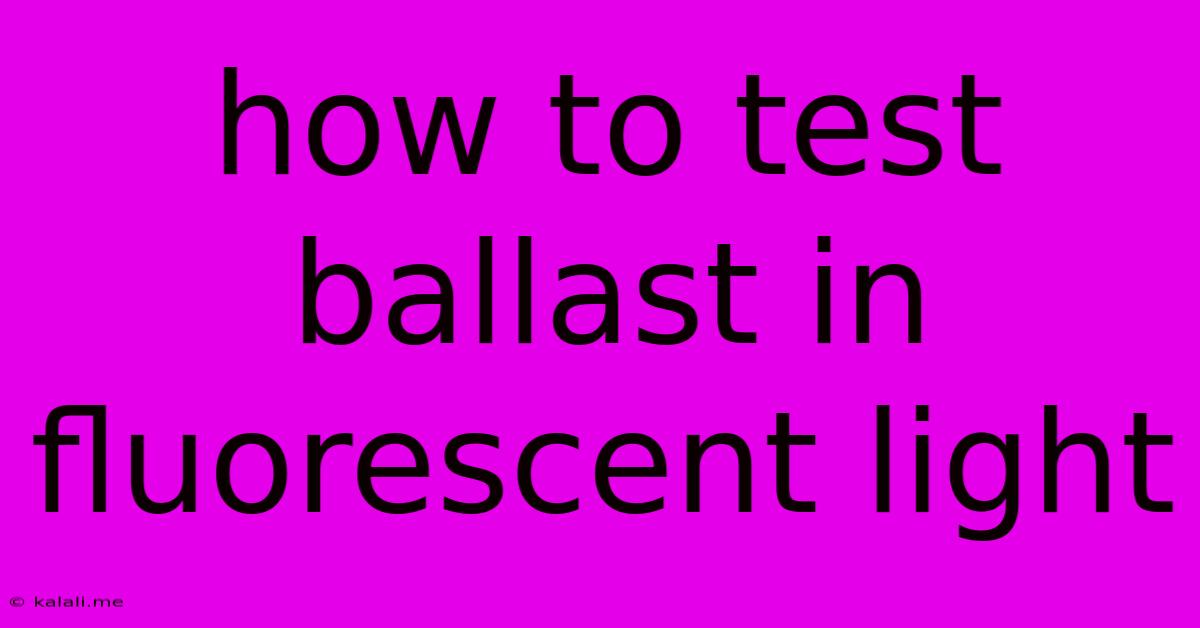How To Test Ballast In Fluorescent Light
Kalali
Jun 07, 2025 · 4 min read

Table of Contents
How to Test a Fluorescent Light Ballast: A Comprehensive Guide
Fluorescent lights, while energy-efficient, can sometimes malfunction. Often, the culprit isn't the bulb itself, but the ballast—the component that regulates the electrical current to the bulb. This guide will walk you through how to test a fluorescent light ballast to determine if it's the source of your lighting problems. Knowing how to diagnose a faulty ballast can save you time, money, and frustration. We'll cover both simple visual inspections and more advanced testing methods.
Understanding the Ballast's Role: Before we dive into testing, let's briefly understand what a ballast does. It's a crucial component in a fluorescent lighting system, responsible for starting and regulating the flow of electricity to the fluorescent tube. Without a properly functioning ballast, your fluorescent light won't illuminate. Common issues with ballasts include buzzing sounds, flickering lights, and complete failure to light.
Visual Inspection: The First Step
Before resorting to more complex testing, begin with a thorough visual inspection of the ballast. Look for:
- Physical Damage: Check for any visible signs of damage, such as cracks, burns, or loose wiring. A physically damaged ballast is almost certainly faulty and needs replacing.
- Loose Connections: Inspect all wiring connections to the ballast. Loose or corroded connections can interrupt the electrical flow and prevent the light from working. Tighten any loose connections.
- Burning Smell: A burnt smell emanating from the ballast is a strong indicator of internal damage and failure.
Testing the Ballast: Two Methods
There are two primary methods to test a fluorescent light ballast: using a multimeter and using a known good fluorescent bulb.
Method 1: Using a Multimeter (More Precise)
This method requires a multimeter, a common tool for electricians and DIY enthusiasts. Safety First: Always disconnect the power supply to the ballast before beginning any testing.
- Prepare your multimeter: Set your multimeter to measure AC voltage.
- Identify the ballast terminals: Fluorescent ballasts typically have several terminals. You'll need to identify the terminals connected to the fluorescent lamp and the power supply. Consult your ballast's wiring diagram if needed. There are usually two terminals for the input voltage and two (or more for higher wattage) for the lamp.
- Measure the input voltage: Connect the multimeter probes to the input terminals of the ballast. With the power connected, the reading should match your mains voltage (e.g., 120V or 230V). A significantly lower or higher reading may indicate a problem.
- Measure the output voltage (across the lamp terminals): Connect your multimeter probes to the terminals that connect to the fluorescent tube. The multimeter should be set to the appropriate range for AC voltage measurement. With the power OFF, it should read 0V. Do not apply power with the multimeter connected to the output terminals. This test primarily checks for shorts.
- Inspect for shorts or continuity: Set your multimeter to the continuity test setting. Test for continuity between any of the lamp terminals and the input terminals. If there's continuity where there should be no connection, that indicates a short circuit within the ballast.
Important Note: The exact voltage readings and testing procedures might vary slightly depending on the type of ballast (magnetic or electronic).
Method 2: Using a Known Good Fluorescent Bulb (Simpler Method)
This method requires a spare fluorescent bulb that you know is functioning correctly.
- Replace the bulb: Remove the suspected faulty bulb and install a known good fluorescent bulb.
- Observe the light: If the light now functions correctly, the original bulb was likely the problem. If the problem persists, the ballast is the likely culprit. This method isn't as precise as using a multimeter, but it's a quick and easy way to rule out a faulty bulb.
Replacing the Ballast
Once you've confirmed that the ballast is faulty, replacing it is usually straightforward. Remember to:
- Turn off the power: Always disconnect the power supply before working with any electrical components.
- Match the specifications: Purchase a replacement ballast that matches the specifications of the original ballast. Incorrect specifications can cause damage to other components.
- Follow the wiring diagram: Pay close attention to the wiring diagram to ensure that you connect the wires correctly.
By following these steps, you can effectively test your fluorescent light ballast and determine if it requires replacement. Remember, safety is paramount, so always prioritize turning off the power before beginning any testing or replacement procedures.
Latest Posts
Latest Posts
-
How To Remove Drill Bit Dewalt
Jun 08, 2025
-
How To Clear Cookies On Twitter
Jun 08, 2025
-
Cardholder Name American Express Gift Card
Jun 08, 2025
-
Can I Take Glass On A Plane
Jun 08, 2025
-
Cups In Box Of Powdered Sugar
Jun 08, 2025
Related Post
Thank you for visiting our website which covers about How To Test Ballast In Fluorescent Light . We hope the information provided has been useful to you. Feel free to contact us if you have any questions or need further assistance. See you next time and don't miss to bookmark.